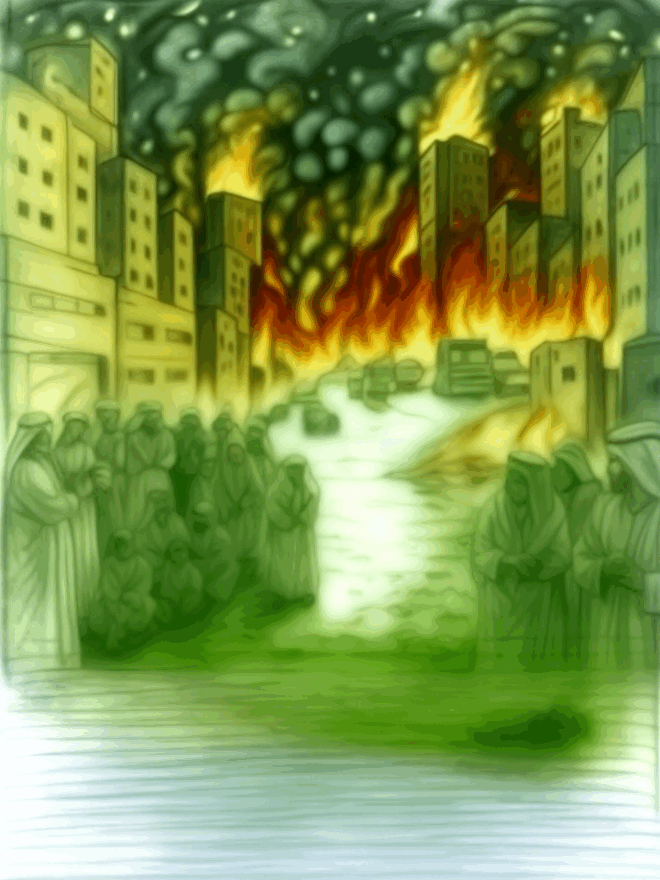
The Middle East remains a cauldron of conflict, with Israel’s threat to bomb Iran threatening to escalate an already volatile region. Since its intensified military operations in Gaza following Hamas’s October 7, 2023, attack, Israel has conducted strikes in three Muslim-majority countries – Syria, Lebanon and Yemen. Bombing Iran would mark a fourth, amplifying accusations that Israel is a primary destabilising force. However, Iran’s support for proxy militias, its nuclear ambitions and the actions of other regional and global actors complicate this narrative. The ongoing war in Gaza, with no ceasefire in place and the growing international push, particularly from European countries, to recognise an independent Palestinian state further intensify the region’s dynamics. This post evaluates the implications of Israel bombing Iran, analyses Israel’s current actions in Gaza, examines the threats of Palestinian state recognition and critically assesses who is destabilising the Middle East.
Background and Regional Context
The current escalation traces back to Hamas’s October 7, 2023, attack, which killed approximately 1,200 Israelis and took 253 hostages. Israel’s response in Gaza, aimed at dismantling Hamas’s military and governing capabilities, has resulted in over 43,000 Palestinian deaths (per Gaza’s Health Ministry as of late 2024) and widespread destruction. As of May 2025, no ceasefire is in place and hostilities continue. Beyond Gaza, Israel has targeted Iran-backed groups across the region:
• Lebanon: Israel launched Operation Northern Arrows against Hezbollah, an Iran-backed militia, following Hezbollah’s attacks on northern Israel in solidarity with Hamas. The killing of Hezbollah’s leader, Hassan Nasrallah, in September 2024 and a fragile November 2024 ceasefire weakened Hezbollah, but Israel maintains positions in southern Lebanon and skirmishes persist.
• Syria: Israel intensified strikes on Iranian and Hezbollah-linked targets, including a September 2024 raid near Masyaf targeting an alleged missile factory. Strikes continued after the Assad regime’s fall in December 2024 to prevent Iran from re-establishing influence.
• Yemen: Israel bombed Houthi targets in response to missile and drone attacks on Israel and Red Sea shipping, with the Houthis, backed by Iran, acting in solidarity with Hamas.
Iran has shifted from its proxy-based strategy to direct confrontation, launching missile and drone attacks on Israel in April and October 2024, retaliating for Israeli strikes, including the bombing of Iran’s Damascus embassy. Israel’s October 2024 response targeted Iranian military infrastructure, avoiding nuclear or oil facilities to limit escalation. Iran’s threats of a “crushing response” and Israel’s warnings of further strikes, particularly over Iran’s nuclear program, keep tensions high.
The premise that bombing Iran would mean Israel has targeted four “independent Muslim-majority countries” oversimplifies the conflict. Syria, Lebanon and Yemen are fractured states hosting Iran-backed non-state actors. Israel’s strikes focus on these groups, but civilian casualties and sovereignty violations fuel criticism. Iran’s Axis of Resistance – Hamas, Hezbollah, the Houthis and Iraqi militias – coordinates attacks to pressure Israel, while the United States, Gulf states, Turkey, Russia and China shape the broader conflict.
Israel’s Current Actions in Gaza
Israel’s military operations in Gaza, ongoing since October 2023, remain intense and highly controversial. The campaign’s objectives are to eliminate Hamas’s military capabilities, secure the release of remaining hostages (approximately 100 as of May 2025, some believed dead) and prevent future attacks from Gaza. Israel has conducted extensive air and ground operations, including raids in northern Gaza (Jabalia and Beit Hanoun), central Gaza (Deir al-Balah) and southern Gaza (Khan Younis and Rafah). These operations have destroyed much of Gaza’s infrastructure, including homes, schools and hospitals, displacing over 2 million of Gaza’s 2.3 million residents.
The Gaza Health Ministry, run by Hamas, reports over 43,000 deaths as of late 2024, with figures likely higher by May 2025. These numbers are disputed, as they may include combatants and lack independent verification, but the scale of civilian casualties is undeniable. Israel claims to have killed thousands of Hamas fighters, destroyed tunnel networks and seized weapons caches, significantly degrading Hamas’s capabilities. However, Hamas continues to launch rockets and conduct guerrilla attacks, indicating resilience despite heavy losses.
Israel’s tactics have drawn global condemnation. Heavy bombardment in densely populated areas, including strikes on alleged Hamas targets in civilian infrastructure, has caused high civilian casualties. The tightened blockade of Gaza has restricted access to food, water, fuel and medical supplies, exacerbating a humanitarian crisis. The UN reports famine-like conditions in parts of Gaza, with over 80% of residents reliant on aid, much of which is delayed or blocked. Human rights organisations, including Amnesty International and Human Rights Watch, have accused Israel of disproportionate force, collective punishment and potential war crimes. Israel insists it adheres to international law, targeting only military objectives and taking measures to minimise civilian harm, but the scale of destruction undermines these claims.
Domestically, the Gaza war is polarising. Hardline factions in Prime Minister Benjamin Netanyahu’s coalition advocate for reoccupying Gaza or expanding settlements, while moderates and opposition leaders urge a political solution to avoid perpetual conflict. The war has strained Israel’s economy, with military costs, reservist call-ups and disrupted trade prompting credit rating downgrades. Public frustration over the failure to secure all hostages and the prolonged conflict has fuelled protests, though security concerns maintain support for military operations.
Internationally, Gaza has galvanised anti-Israel sentiment. Pro-Palestinian protests have surged globally and the humanitarian crisis has prompted diplomatic initiatives, particularly in Europe, to recognise an independent Palestinian state. The lack of a ceasefire, combined with mounting casualties, has eroded Israel’s standing, even among allies, complicating its broader regional strategy, including against Iran.
Threats to Recognise an Independent Palestinian State
The ongoing Gaza conflict has reinvigorated international efforts to recognise an independent Palestinian state, particularly among European countries and others, as a response to Israel’s actions and the stalled peace process. Key developments as of May 2025 include:
• European Initiatives: In May 2024, Ireland, Norway and Spain formally recognised Palestine, joining Sweden (2014), citing Israel’s Gaza operations and the need to advance a two-state solution. Recognition is based on the 1967 borders, with East Jerusalem as the capital. France, Belgium and Portugal have signalled openness, with France’s parliament passing a non-binding resolution in December 2024 urging recognition. The United Kingdom, under a Labour government since July 2024, is reportedly considering recognition but faces domestic political constraints. Germany and Italy remain cautious, prioritising negotiations, though public pressure is growing.
• Other Countries: Beyond Europe, South Africa, Brazil and Colombia have intensified calls for Palestinian statehood. South Africa leads a genocide case against Israel at the International Court of Justice (ICJ), filed in December 2023, alleging violations in Gaza. In November 2024, the UN General Assembly passed a resolution, supported by over 140 countries, affirming Palestinian self-determination and urging recognition, though it lacks binding force.
• Implications for Israel: Recognition by major Western nations would isolate Israel diplomatically, potentially leading to sanctions, reduced aid, or boycotts. It could legitimise Palestinian claims in international forums, strengthening ICJ and International Criminal Court (ICC) cases, where Israel faces investigations for alleged war crimes. Israel views unilateral recognition as a threat to its security, arguing it rewards Hamas’s violence and bypasses negotiations.
• Palestinian Perspective: The Palestinian Authority (PA) welcomes recognition as a step toward statehood but emphasises that unilateral moves cannot replace a negotiated two-state solution. Hamas supports recognition but demands a single state encompassing all of historic Palestine, complicating diplomacy.
• US and Regional Stance: The US opposes unilateral recognition, advocating for direct negotiations, but faces pressure from progressive Democrats to shift policy. The Trump administration, since January 2025, has doubled down on supporting Israel, dismissing recognition efforts. Gulf states like Saudi Arabia, open to normalising ties with Israel, condition progress on Palestinian statehood, as reiterated at the 2024 Arab League summit.
These moves reflect frustration with Israel’s actions in Gaza and the lack of progress toward a two-state solution. However, recognition without a negotiated framework risks entrenching divisions, as Israel vows to expand settlements in response. The threat of recognition adds pressure on Israel, potentially weakening its leverage against Iran amid growing isolation.
Implications of Israel Bombing Iran
Israel’s decision to bomb Iran involves weighing strategic imperatives against catastrophic risks. Below are the arguments for and against, followed by strategic considerations.
Arguments for Bombing Iran
1. Countering the Nuclear Threat: Israel views Iran’s nuclear program as an existential threat, particularly amid reports of Iran nearing weaponisation. Preemptive strikes on nuclear facilities could delay or prevent a nuclear-armed Iran, preserving Israel’s security.
2. Disrupting Iran’s Proxy Network: Strikes on Iranian military infrastructure could weaken Iran’s ability to arm Hezbollah, the Houthis and Hamas, reducing threats to Israel. A decisive blow might deter further aggression.
3. Strengthening Regional Alliances: Acting against Iran could solidify Israel’s alignment with the US and Gulf states, advancing normalisation under the Abraham Accords.
Arguments Against Bombing Iran
1. Risk of Regional War: An attack could trigger retaliation from Iran’s ballistic missiles and proxies, potentially involving Hezbollah, the Houthis and Hamas. This risks a regional war, drawing in the US and possibly Russia.
2. Humanitarian and Economic Costs: Strikes on Iranian infrastructure, especially oil facilities, could deepen Iran’s economic crisis, harm civilians and spike global energy prices, destabilising the region.
3. International Backlash: Israel’s operations in Gaza, Lebanon and Syria have drawn condemnation. Bombing Iran could exacerbate isolation, especially amid growing support for Palestinian statehood.
4. Limited Effectiveness: Iran’s nuclear facilities are dispersed and fortified, making a successful strike difficult. Historical examples, like Israel’s 1981 Osirak raid, show that strikes delay but do not eliminate nuclear ambitions.
Strategic Considerations
Israel’s October 2024 strike on Iranian military targets demonstrated restraint, avoiding escalation while signaling capability. A similar approach could degrade Iran’s military without provoking all-out war, but miscalculations could spiral, especially with Gaza’s ongoing conflict fuelling regional tensions. Domestic pressures in Israel for decisive action and in Iran for retaliation complicate de-escalation. Diplomacy, such as US-led nuclear talks, offers an alternative, but Iran’s hardline stance and Israel’s distrust limit prospects. The push for Palestinian statehood adds pressure, as bombing Iran could worsen Israel’s isolation, undermining its position against both Iran and the Palestinian issue.
Who Is Destabilising the Middle East?
Determining who is destabilising the Middle East requires examining the roles of Israel, Iran and other actors, acknowledging that no single party bears sole responsibility.
Israel’s Role
Destabilising Actions: Israel’s campaigns in Gaza, Lebanon, Syria and Yemen have caused significant civilian casualties and infrastructure damage, fueling resentment and radicalisation. The ongoing Gaza war, with no ceasefire, has displaced over 2 million people, drawing global condemnation and undermining international norms. Strikes on sovereign nations, even targeting non-state actors, violate sovereignty and escalate tensions. Settlement expansion in the West Bank and Gaza’s humanitarian crisis have galvanised calls for Palestinian statehood, isolating Israel.
Stabilising Actions: Israel argues that its operations counter terrorist groups and Iran’s malign influence, which threaten regional stability. By weakening Hamas, Hezbollah and the Houthis, Israel claims to enhance security for itself and allies like the US and Gulf states. Efforts to secure hostages and prevent Gaza from becoming a launchpad for attacks reflect security priorities.
Context: Israel’s actions stem from security imperatives, particularly after October 7, 2023, exposed vulnerabilities. However, the scale of its responses, especially in Gaza, has amplified instability by radicalising populations and strengthening Iran’s narrative of resistance.
Iran’s Role
Destabilising Actions: Iran’s support for the Axis of Resistance has fuelled conflicts across the region. Its direct attacks on Israel in 2024 and proxy attacks, including Hamas’s ongoing operations, escalate tensions. Iran’s nuclear ambitions, with hints of weaponisation, raise fears of a nuclear arms race.
Stabilising Actions: Iran frames itself as a counterweight to Israeli and Western hegemony, supporting groups that claim to resist occupation. Its restrained responses to some Israeli strikes suggest an interest in avoiding all-out war to preserve domestic stability.
Context: Iran’s proxy strategy projects power without direct confrontation, but setbacks to Hamas, Hezbollah and the Assad regime have weakened its influence. Its nuclear rhetoric sustains tensions, but economic constraints and domestic unrest limit its capacity for large-scale escalation.
Other Actors
1. United States: The US enables Israel’s operations through military aid and arms, contributing to escalation, while conducting anti-Houthi strikes. Its diplomatic efforts, such as nuclear talks, aim to contain conflicts, but inconsistent policies undermine its stabilising role.
2. Non-State Actors: Hamas, Hezbollah and the Houthis initiate attacks on Israel and Western interests, inviting retaliation and perpetuating violence. Hamas’s ongoing resistance in Gaza and Houthi Red Sea attacks amplify instability.
3. Regional Powers: The fall of Assad has empowered Turkey and Sunni Islamist groups, potentially hostile to Iran. Saudi Arabia and the UAE align with Israel against Iran but pursue their own agendas in Yemen and Syria, complicating peace efforts.
4. Russia and China: Russia’s support for Iran and Syria, including reported nuclear assistance and China’s economic ties with Iran sustain anti-Western axes, indirectly fueling instability.
5. European and Global Actors: European moves to recognise Palestine reflect frustration with Israel’s actions but risk entrenching divisions without a negotiated solution. The Global South’s support for Palestine adds diplomatic pressure but complicates multilateral efforts.
Critical Analysis
The Middle East’s instability results from a web of interdependent actions. Israel’s aggressive posture in Gaza and beyond has inflamed tensions, eroded international norms and fuelled calls for Palestinian statehood, but it responds to threats from Iran-backed groups, including Hamas’s ongoing attacks. Iran’s proxy warfare and nuclear brinkmanship escalate conflicts, but it positions itself as resisting imperialism. The US and other powers exacerbate instability through selective support and inconsistent diplomacy, while non-state actors thrive in the chaos.
The framing of Israel bombing four “independent Muslim-majority countries” oversimplifies the conflict. Syria, Lebanon and Yemen are battlegrounds for proxy wars, with Iran’s influence a key driver. Israel’s strikes target these proxies, but civilian suffering and sovereignty violations amplify anti-Israel sentiment. The ongoing Gaza war, with no ceasefire and the push for Palestinian statehood highlight the need for a holistic approach addressing Iran’s proxy network, Israel’s disproportionate responses, the Palestinian question and regional governance failures.
Conclusion
Israel should refrain from bombing Iran, as the risks of regional war, humanitarian fallout and international isolation outweigh the benefits of delaying Iran’s nuclear program. A restrained approach, combined with US-led diplomacy, offers a less catastrophic path, though mutual distrust and Israel’s isolation, exacerbated by Gaza and Palestinian statehood recognition, limit prospects.
No single actor is solely responsible for destabilising the Middle East. Israel and Iran, through their military actions and proxy wars, are primary drivers, exacerbated by US enabling, non-state actors’ aggression and regional powers’ competing agendas. The ongoing Gaza conflict and international support for Palestinian statehood add complexity, underscoring the need for de-escalation: a Gaza ceasefire, Hezbollah’s disarmament, a resolution to Iran’s nuclear ambitions and progress toward a negotiated two-state solution. These goals require multilateral cooperation and compromise, which remain elusive in May 2025. Diplomacy, not destruction, is the region’s best hope for peace.


